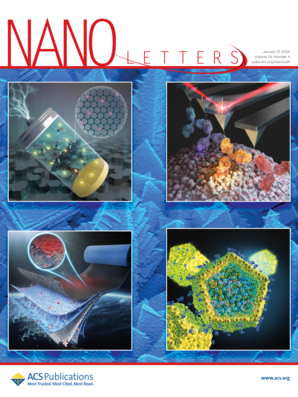合理设计由二维金和MXene Sc2CF2组成的多功能异质结构
IF 9.6
1区 材料科学
Q1 CHEMISTRY, MULTIDISCIPLINARY
引用次数: 0
摘要
通过接触工程合理设计二维金属半导体异质结构对于开发下一代纳米电子器件至关重要。本文采用范德华设计策略探讨了金与MXene Sc2CF2的接触特性。我们的研究结果表明,在所有金/Sc2CF2异质结构中都形成了n型肖特基触点。值得注意的是,这种异质结构在n型和p型肖特基触点之间具有可逆切换,并且可以通过电门控和垂直应变从肖特基触点调谐到欧姆触点。此外,金/Sc2CF2具有较低的隧道电阻率,为2.80 × 10-10 Ω cm2,表明其具有良好的电荷注入效率。这些发现为金基器件的设计和优化提供了有价值的理论指导,如场效应晶体管(fet)和光电探测器。本文章由计算机程序翻译,如有差异,请以英文原文为准。

Rationally Designed Versatile Heterostructures Consisted of Two-Dimensional Goldene and MXene Sc2CF2
The rational design of two-dimensional (2D) metal–semiconductor (M–S) heterostructures through contact engineering is crucial for the development of next-generation nanoelectronic devices. In this Letter, van der Waals design strategies were employed to explore the contact characteristics between goldene and MXene Sc2CF2. Our findings reveal that n-type Schottky contacts are formed across all goldene/Sc2CF2 heterostructures. Notably, this heterostructure exhibits reversible switching between n- and p-type Schottky contacts and can be tuned from Schottky to ohmic contacts via electric gating and vertical strain. Furthermore, goldene/Sc2CF2 exhibits a low tunneling specific resistivity of 2.80 × 10–10 Ω cm2, indicating its excellent charge injection efficiency. These findings offer valuable theoretical guidance for the design and optimization of goldene-based devices, such as field-effect transistors (FETs) and photodetectors.
求助全文
通过发布文献求助,成功后即可免费获取论文全文。
去求助
来源期刊

Nano Letters
工程技术-材料科学:综合
CiteScore
16.80
自引率
2.80%
发文量
1182
审稿时长
1.4 months
期刊介绍:
Nano Letters serves as a dynamic platform for promptly disseminating original results in fundamental, applied, and emerging research across all facets of nanoscience and nanotechnology. A pivotal criterion for inclusion within Nano Letters is the convergence of at least two different areas or disciplines, ensuring a rich interdisciplinary scope. The journal is dedicated to fostering exploration in diverse areas, including:
- Experimental and theoretical findings on physical, chemical, and biological phenomena at the nanoscale
- Synthesis, characterization, and processing of organic, inorganic, polymer, and hybrid nanomaterials through physical, chemical, and biological methodologies
- Modeling and simulation of synthetic, assembly, and interaction processes
- Realization of integrated nanostructures and nano-engineered devices exhibiting advanced performance
- Applications of nanoscale materials in living and environmental systems
Nano Letters is committed to advancing and showcasing groundbreaking research that intersects various domains, fostering innovation and collaboration in the ever-evolving field of nanoscience and nanotechnology.
 求助内容:
求助内容: 应助结果提醒方式:
应助结果提醒方式:


